The Turtle I
LA TORTUGA AZUL – THE TURTLE I
The Original Turtle
Sold in 1981 for $16,000
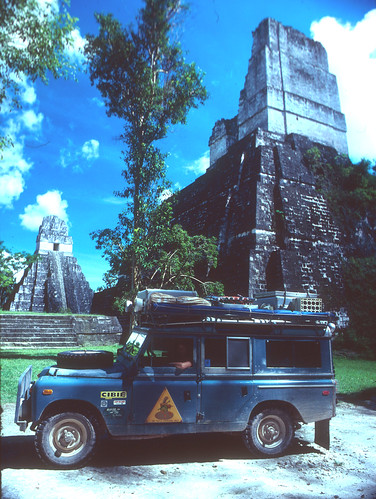
Temple Five in Mayan ruins of Tikal, deep in the Guatemalan jungle, were as impressive as our now road-proven Land Rover.
Back in 1970, when the idea of The Turtle Expedition was being conceived, a 1967 109 long wheel-base Land Rover with the tire on the hood seemed the obvious choice for a rugged international travel vehicle. A custom interior was designed to sleep two and carry the mountain of supplies we imagined we needed for a five-year trip to and around South America. Several thousand dollars were spent rebuilding the 6-cylinder gasoline engine, the suspension, wheels, tires, etc. We originally called it La Tortuga Azul, (The Blue Turtle), because it was very slow and carried its house on its back. The name of The Turtle Expedition followed.
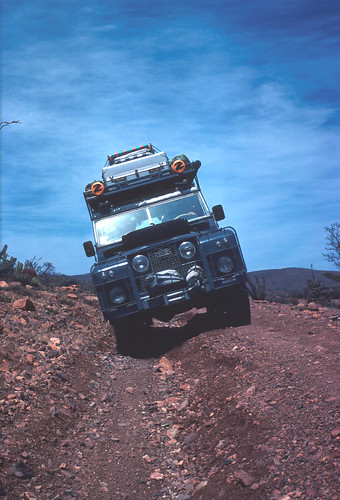
The Land Rover, with its narrow wheel base, was always top-heavy. This was aggravated on roads made by American pick-ups in Mexico and Central America. We often drove with one wheel on the center berm.
Early on, there was a lesson to be noticed. When the dual Rolls Royce electric fuel pump died, the Land Rover dealer in Reno, NV, advised us that the $120.00 pump was back ordered. We installed a $15.00 AC pump, and the Land Rover got better.
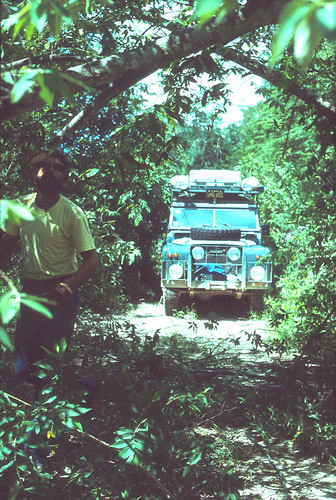
Working our way up an abandoned trail in the Guatemalan jungle, we resorted to chopping vines and limbs out of our way. The spectacular Tikal ruins was a just reward.
A year later we filled the tank in Hermosillo, Mexico, and the high compression six, originally designed for the Rover car, nearly choked to death! We kept it running by mixing 130-octane aviation fuel with Pemex Nova, but it was never really happy. Two years later, the Rover six was swapped for a Chevy 250 six, and the Land Rover again got better. Every time we replaced a Land Rover part with an American part, the truck got more reliable.
Over a nine year period, other modifications were made and The Turtle, as it came to be called by Off Road Magazine readers, evolved into something of a space capsule. When we parked, everything came out on tethers. The kitchen, chairs, table, awning, stereo speakers, ice chest—we lived around The Turtle, not in it.
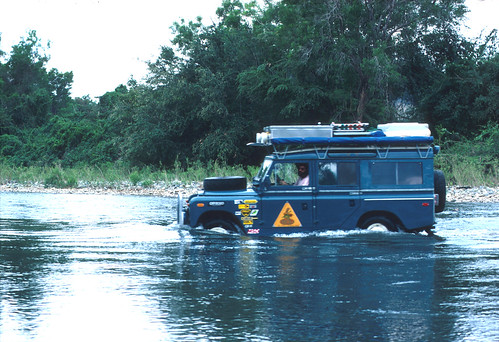
Early in the adventures of The Turtle Expedition, we learned that some of the most beautiful and secluded beaches were not reached by paved roads. This trail south of Manzanillo was no exception.
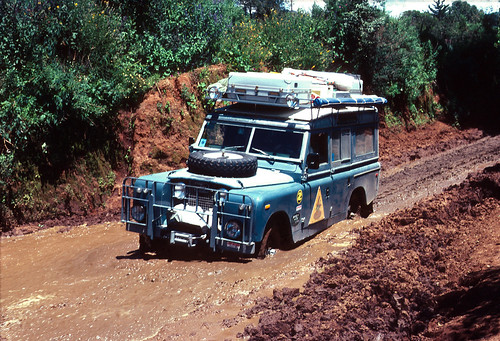
Monika was quick to learn that there were two choices. Drive, or walk ahead with the camera and check for snakes and alligators. Crossing this quagmire was the only way to reach the back side of Lake Zirahuen in Michoacan, Mexico.
Impressive a vehicle as it was, it was still a 1967 Land Rover, sort of a street-legal tractor. The transmission had no syncro in 1st—sounded like a coffee grinder. The doors leaked and flapped in the wind, the axles snapped on a regularly basis, and holding a conversation without yelling was impossible. The imagined international availability of parts was a myth. As we traveled further and further south, insects and weather got progressively worse. By the time we reached Belize and Guatemala, it was clear that we needed a camper that we could, at least sometimes, live in. La Tortuga Azul was sold and The Turtle II was born.
Specifications In A Nutshell
Base Vehicle – 1967 109 Land Rover Station Wagon
Design and Assembly – The Turtle Expedition, Unlimited
Engine – Chevy 250 six cylinder
Torque – Plenty
Horsepower – Enough@3,000 RPM On hills you could read a book
Transmission – Land Rover four-speed with Fairy overdrive
Transfer Case – Land Rover four-speed
Locking Hubs – Selectro
Suspension – Burbank springs with Rough Country shocks
Rear Differential – Land Rover
Front Differential -Land Rover
Tires – Sears Mud & Snow
Wheels – Land Rover
Weight – 9,000 lbs. fully loaded
Fuel Capacity – 30 Gallons
Camper – Custom built
Details:
GENERAL HISTORY 1970 to 1981
Back in 1969, I was sitting in the Pudding Shop in Istanbul, sipping a cup of thick Turkish coffee. I had started in Amsterdam with a backpack, and had made it as far as Herat, Afghanistan. Wonderful trip! But I was totally fed up with hitching and all forms of public transportation. About that time, a blue Land Rover DormMobile pulled up in the little park across the street and popped up its funny coffin top. That, I said to myself, was the way to travel!
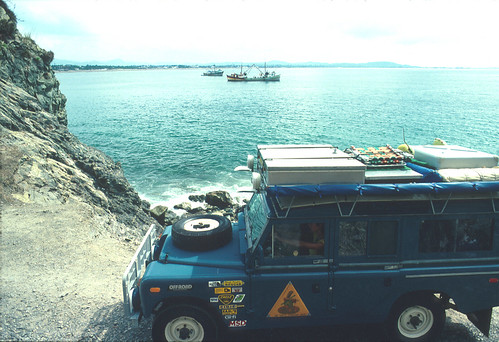
Always in need of more storage, in a later version of the Rover’s roof rack we added an aluminum box in front. The custom folding kitchen nestled on slide-out rails in the center. Note the anti-glare shields on the overhead driving lights.
The dream never died. After returning home, and making a second trip to Turkey with Joy Gerlach to import meerschaum pipes and Turkish coats, we moved to South Lake Tahoe to become ski bums. Joy was to be the co-founder of The Turtle Expedition. In 1970, or thereabouts, we were in San Francisco walking by the British Motors dealer, and there it was, a 1967 109 long wheelbase, fresh off a rabbit farm across the bay. Price; $6,000.00. It was the last year, at the time, for the 109’s to be imported.
The rest is history. Three attempts to build the camper ended in the final working model. Springs, tires, rebuild the engine, roof racks and lists as long as your arm followed for another year and a half before we actually drove away, but that ís another story.
ENGINE:
The engine in The Turtle was originally the Rover 2000 six cylinder, detuned and offered to the North American market, we suspect, to give the Land Rover Station Wagon some highway capability. It was a horrible engine, with a canister-type oil filter and valves that needed adjusting every 6,000 miles by a trained Land Rover mechanic. After a year in Mexico, we returned to the U.S. to swap the engine for a Chevy 250-six cylinder, a far superior engine, far more reliable, far easier to get parts for, far easier to maintain, and better mileage to boot. The engine adapter was designed by Scotty’s Foreign Car Service in Concord CA, and painstakingly installed in Scotty’s Land Rover cemetery, where Gary lived in a 15-foot trailer during the two-month operation. The Roverlet, as it was called, was a bloody smashing success, and never missed a beat for the rest of The Turtle’s life.
FUEL:
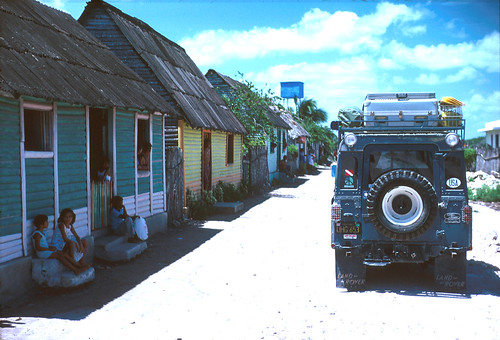
The rear tire mount on 1967 Land Rovers was a problem. In fact, the whole door was a problem. We added a third hinge and reinforced the inner frame of the door to support the tire. The fishing village of El Cuyo on the remote Yucatan coast could not recall the last tourists they had seen.
The original Rover six required high-octane leaded gas. On its first sip of Mexican regular, it belched, wheezed, coughed and nearly choked to death. We quickly switch to the reserve tank, and made it to the nearest airport. For the remainder of the first year in Mexico, we mixed a cocktail of Pemex Nova, 130-octain aviation fuel, and a shot of Marvel Mystery Oil. So much for its international travel capability! The Chevy six ran on anything we fed it, and I gave up my job as a bartender.
EXHAUST:
The stock Land Rover exhaust was scrapped with the engine, and a set of Hooker Headers were adapted to a glass-pack muffler. This, in theory, like all headers, gave us some incremental boost in horse power and torque, primarily above 6,000 rpm on the back straightaway. Normally it was just a fancy exhaust system.
COOLING:
A custom heavy-duty cross-flow radiator was designed to fit the space available. A remote fan set-up was engineered to draw air through the top-center of the radiator,—the hottest area—, and a custom shroud was made.
ELECTRICAL:
The original electric system on the Land Rover was by Lucas—King of Darkness. It was modified and modernized with the Chevy engine, but basically, the entire Land Rover still ran off two barrel fuses. A GNB deep-cycle sealed battery was mounted under the driver’s seat in an unvented compartment. It ran everything, and it never exploded.
TRANSMISSION & TRANSFER CASE:
The stock Land Rover four-speed transmission, two-speed transfer case, and clutch were retained, and a Fairy Overdrive was added, giving us 16 forward speeds. Mostly only six or seven were ever used. The transmission had no syncro in first, sounded like a coffee grinder, and had a nasty habit of jumping out of 4th on the freeway. It also leaked like a sieve. If there was no puddle under the Land Rover, something was low on gear oil.
DIFFERENTIALS:
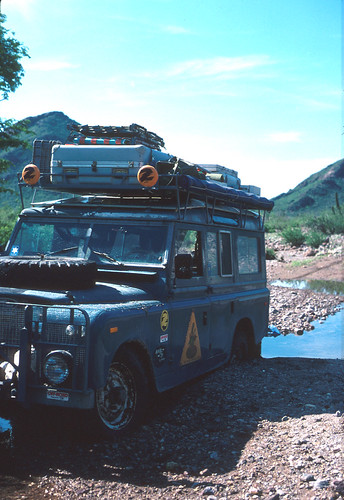
Given the fact that we were not four-wheelers, it should not surprise anyone that we forgot to lock in the front hubs before crossing this sandy arroyo outside of San Carlos, Mexico. It would not be the last time we had to dig the Land Rover out.
Both front and rear differentials were stock. Sometime during its mid-life crisis, we swapped the front for the rear. Both were open, which was like having two-wheel drive or worse when you really needed traction.
DRIVE LINES:
Drivelines remained stock. The driveline emergency brake leaked and never worked, mostly because the brake pads were usually soaked with gear oil. The good news was, it never rusted either.
BRAKES:
The brakes on a 1967 Land Rover were ludicrous. There was some kind of servo system that never worked. If you pumped frantically three or four times, you might get half a pedal. Only a trained magician could get all the air out of the system. We never did.
AXLES:
The rears broke on a regular basis, like a shear-pin on an outboard motor. We carried spares.
WHEELS AND TIRES:
Starting with stock 16-inch rims, we bent several before switching to Dick Cepek 16.5 X 12-inch wheels and Armstrong Tru-Tracs. They rusted, and we went back to Land Rover 16-inch steel rims.
SUSPENSION:
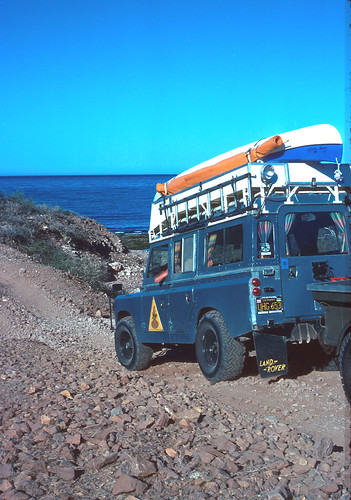
In its original configuration, with a very heavy roof rack and an army utility trailer in tow, La Tortuga Azul, (The Blue Turtle) was a stout backroad explorer, even if a bit top heavy.
We had researched the original Land Rover springs twice. They sagged and broke under our heavy load. Finally, on a trip back to the U.S., we had Tom Loeb, then owner of Burbank Spring Co., design and build us a custom set of springs. End of problem. Rough Country shocks were used all around.
STEERING:
Stock steering. No power. Strong arms.
BUMPERS:
The Turtle’s stock bumpers were retained. A custom heavy-duty grill guard was designed by Gary and installed in South Lake Tahoe. Its purpose was to keep large animals, like cows and burros, from pushing the radiator into the engine. We never had a brush jump out in front of us, so a brush guard was not necessary. An 8,000 lb Warn winch was mounted between the frame rails.
SEATS:
The seats were the original buckboard style, with imitation elephant hide upholstery.
SAFETY HARNESSES:
Land Rovers did not come with seat belts. We adapted some from an American sedan.
CENTER CONSOLE:
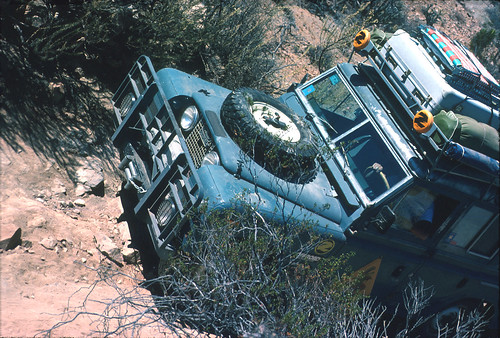
On one of its first Baja California adventures, the Land Rover showed the advantages of low gears and a skinny profile while exploring rocky trails near Puerto Catarina.
A custom mahogany center console was designed and built by Gary. It held some 30 cassettes in its upper compartment, and a Teac AC-9 tape deck nested in a hidden compartment with a spring-loaded trap door.
OVERHEAD CONSOLE:
An aluminum shelf was fabricated to fit over the windshield. It held a stereo pre-amp and the usual maps, books and travel paraphernalia.
OTHER FEATURES:
Over the years, special features were added or modified. The overall design included a folding bed which was a couch during the day, lots of storage, and a counter with sink and hand pump for water. After the original trailer was done away with, a full folding kitchen was designed to slide onto the roof rack and hook on the side. The whole system worked like magic, as long as the weather allowed us to live outside. When it rained, even with a full awning, it was miserable. Still, we have seen many traveling Land Rovers since then, and we have never found one that worked as well as our design.







